Mills in Alto Aragón - harinero
Naval
Naval is renowned for its potteries and salt pans.
From the main road between L'Ainsa and Barbastro turn right in Abizanda where Naval is signposted.
At the foot of the hill with Naval, take the left branch and follow the signs to the
Salinas were there is ample parking space.
Cross the rivulet (one step will do) and follow the path downstream (away from Naval). The path ends into the riverbed.
From this point, walk downstream (to the left) in the river bed for the dam which is only a couple of minutes away.
For the mill, cross the river and follow the earthen road that longs the river (first up and then slowly down again) until you are down into the riverbed once again.
The mill is at the other bank of the Río Llastre.
Pictures: 16.viii.2002, 21.x.2019
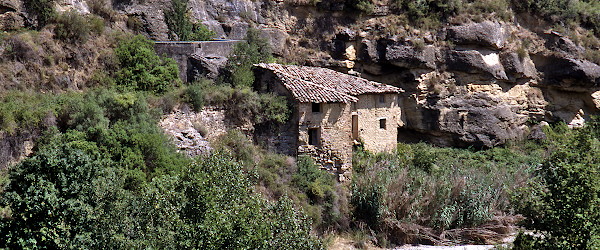
(1) Mill deep in the valley of the river Llastre — 2002.
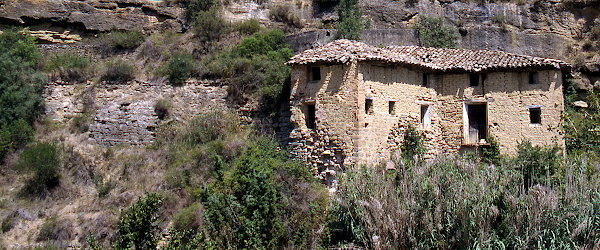
(2) — 2002.
This mill is decaying rapidly and its walls will probably soon disappear
below the high vegetation. At the time of our first visit, in 2002, the outer walls stood still upright
(1–3) and were covered with a roof in a fair condition. We didn't manage to get in, but from the opening in the top layer (9), we could see that most of the inner structure of the building (4) had fallen down.
In 2019 large parts of the roof were also gone and the outer walls showed huge holes. The vegetation
was even more dense than before, but this time we did succeed in working our way though the Spanish cane and enter the building at the ground level. It was not safe to
climb to the upper levels. But we got at least an idea of the layout of this construction of two wings (3, 5) perpendicular to each other.
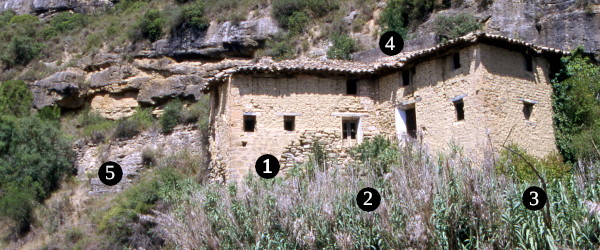
(3) — 2002.
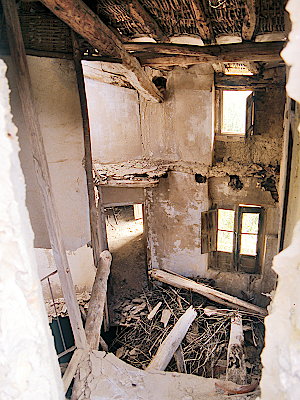
(4) Situation inside seen from
the top layer (the door in 9) — 2002.
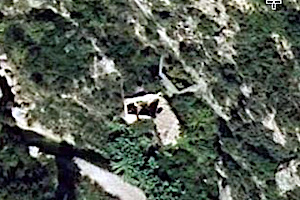
(5) Overview of the site — © IGN.es 2019
The business seemed to be confined to the lowest floors —ground floor and maybe part of the second— while the
rest may have been used for housing. The entrance (6) is situated in the short side (❸) of the southern wing. Two wide wooden doors
open into a spacious reception area (7) which gave access to the working place (8). A wooden staircase leads to the second floor with a large room with some small windows and also large French doors (below the ❹) looking out over the river.
The stone table (8) was situated in the west wing: at the end and maybe a bit lower than
the room with the French doors. It was difficult to determine the exact relative positions of the layers. The ❶ in (3) indicates the approximate position of the wooden table with the stones.
From the top level of the construction (9, 10) a small door gives acces to the mill ponds (❹, ❺).
The lower mill pond (9 and ❺) is probably the oldest one as it is built from masonry, natural rock and earth. The wall ❺ is also visible in (5) as a faint grey line running upwards from
the left wall of the building.
The lower pond is now filled with shrub which makes it difficult the appreciate its exact dimensions, but it could hold a large volume.
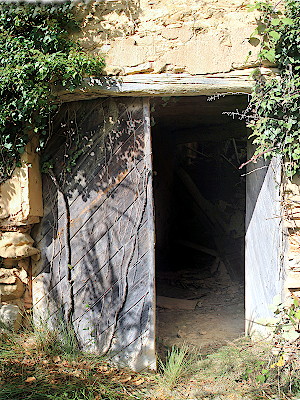
(6) Entrance from outside — 2019
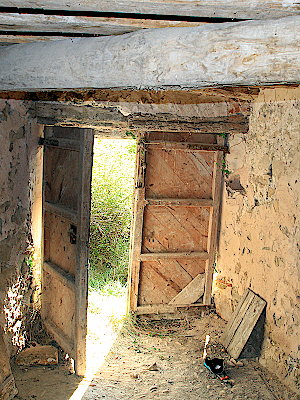
(7) Entrance seen from reception room — 2019
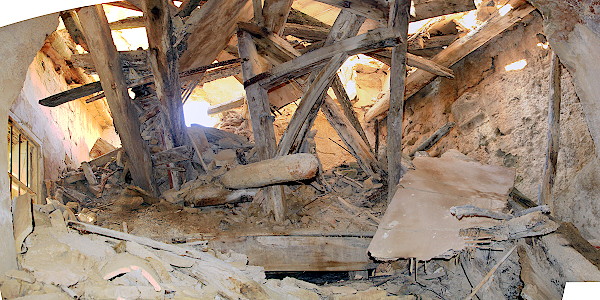
(8) Stone table with the crane; the window left and in (14) are the same — 2019.
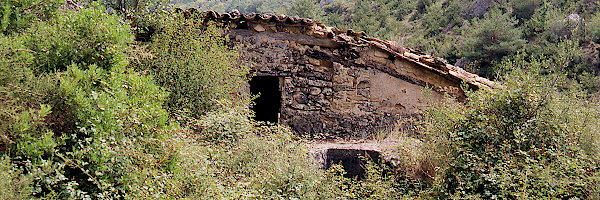
(9) Top layer of the mill with the lower pond and its saetín — 2002.
The upper mill pond (❹, 10, and also visible in 5) is built from concrete.
I am not sure how the system worked.
Did the upper pond replace the lower pond? Were both in use at the same time
or alternating (i.e. running the mill on one pond, while filling the other)? Had the upper pond its
own pressure pipe to the mill, or was the water first drained into the lower reservoir?
Water, having enough for a decent run of the mill, must have
been a constant concern. The río Llastre is only a small rivulet in a dry country and it must have taken a long time
to fill the pond(s).
The dam (azud
, 11) is very well preserved. From there a long channel follow the contours of the ridge.
Not the entire length is visible, but from what can be seen (12), we do learn that its function has been
taken over by tubing laid between its walls.
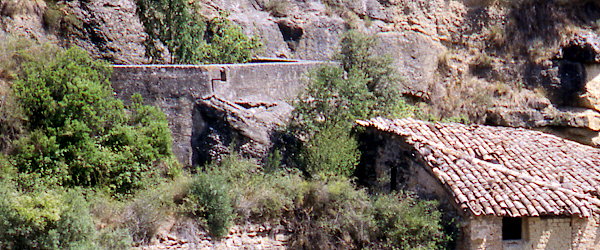
(10) The upper mill pond — 2002.
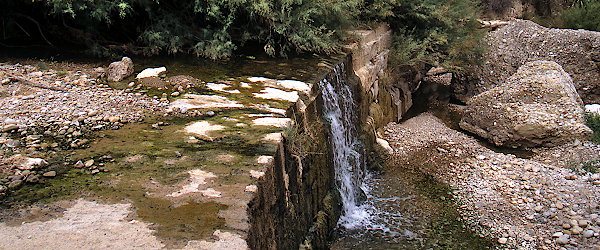
(11) Dam in the río Llastre — 2002.

(12) Pipes in the former canal brings the water to the pond — 2002.
We couldn't make out how the equipment was organised inside the building.
First because of the chaos and secondly because everything metalic must have been robbed.
If there was a wheel (rodete
) or a turbine is not clear. The cárcavo (14, ❷ in 3) is empty and though there
is some kind of tubing in its roof, there is nothing that reminds us of a turbine, nor anything else.
The cárcavo is rather narrow. Its mouth is a nice arch
made from regularly cut stone. The restitution channel first longs the long side of the southern wing of the building
and then flows out in the riverbed. About halfway the wall (13) a cemented washingboard can be seen with cuts
in an irregular rectangular pattern.
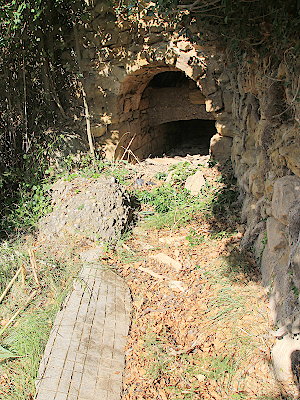
(13) Outlet with a washboard— 2019.
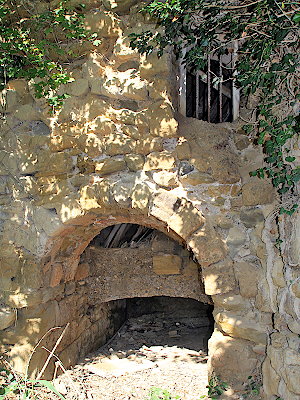
(14) Cárcavo — 2019.
The walls in mills often carry drawings or writings
(e.g.
Labuerda,
Broto,
Berdún)
and it is always worthy to search for faded scribblings, often made in pencil. In this case
there was nothing of interest on the walls, but the harvest on inner face of the entrance door (7) gave cause for satisfaction: several
drawings en some texts (15–18). Two drawings stood out for their detail.
First there is the vehicle on the undulating road (15). The luggage rack carries the text
excursiones and we recognize door handles, cooling grill and gaps,
and several people behind the windows.
Then there is the aircraft (16). It is equipped with three propellers and both wings carry a big white cross. Could this be
a reference to airplanes of the German Legion Condor during the civil war?

(15) — 2019.
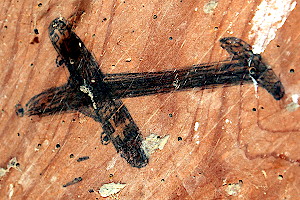
(16) — 2019 .
The third is a short note (17) telling us that
Faustino Coscojuela came to
the mill on the 9th of July 1927 and then he left
The last inscription is difficult to decipher (18). It reports on the dimensions of the wheel and related parts, but some words have become too ghostly. But at least we now know that there was a wheel
at some stage and that the axle, the main beam going through the roof of the cárcavo to the stones,
measured 2.44 m. The pin below the wheel measured 9 cm.

(17) — 2019.
Faustino Coscojuela
vino a el molino
el dia 9–7–27
y se fue
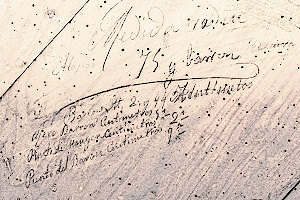
(18) — 2019 .
Medida rodete
????? 75 y barron ????? ?? Centimetros
Barron M 2 y 44 centimetros
Ajero barron centimetros 5 1?
Punto de Margen? Centimetros 2 1?
Punto del Barron Centimetros 9?





















